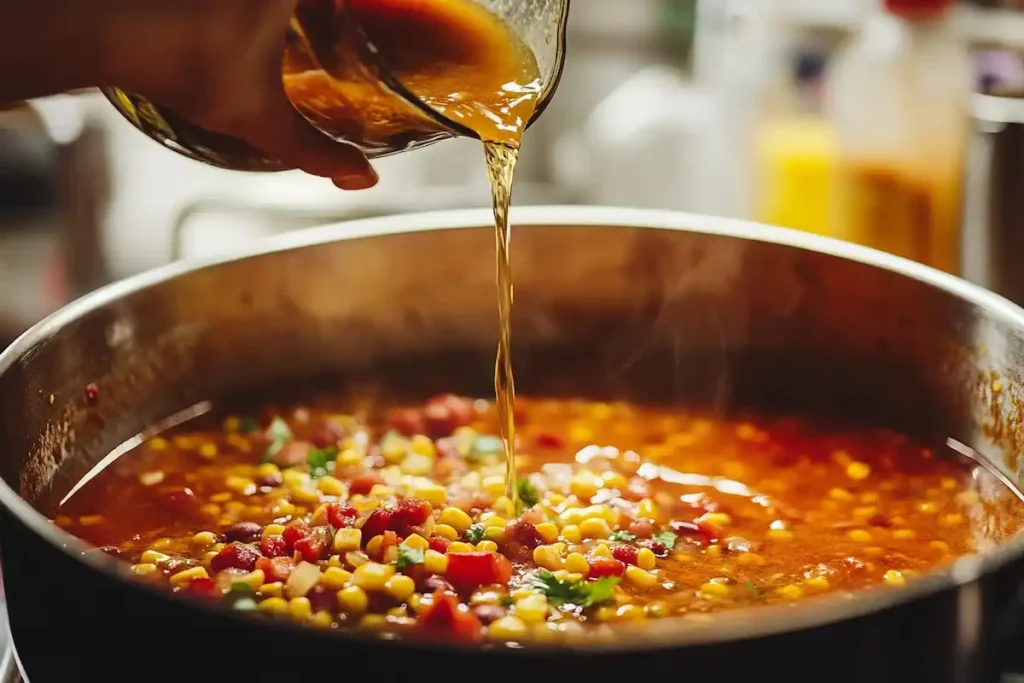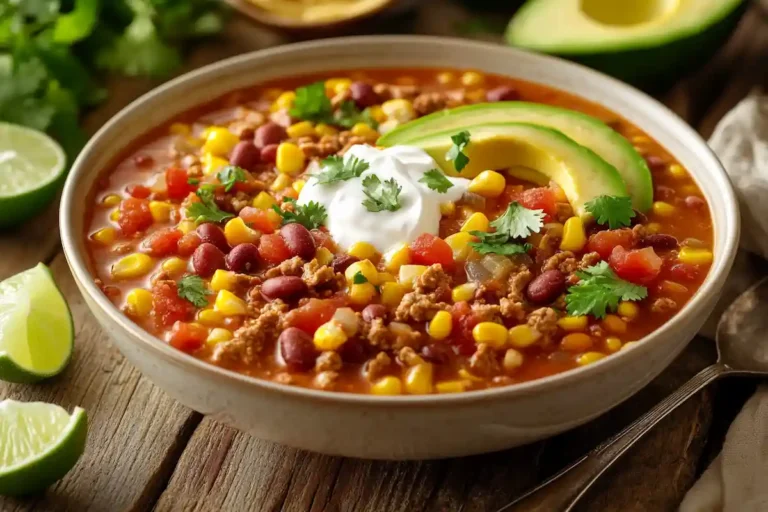Introduction
Taco soup is a delicious and hearty meal that brings together the bold flavors of Mexican cuisine. But sometimes, you might find yourself with a batch that’s just too spicy to enjoy. Whether it’s an overzealous sprinkle of cayenne or chili peppers that pack more heat than expected, there’s no need to toss the whole pot. This guide will walk you through practical, easy-to-follow tips for how to fix taco soup that is too spicy. From immediate fixes to preventative measures, we’ve got you covered!
1. Understanding the Problem: Why Is Your Taco Soup Too Spicy?
What Causes Spiciness in Taco Soup?
Spiciness in taco soup usually stems from key ingredients that bring the heat. Chili peppers, jalapeños, cayenne powder, and hot sauces are common culprits. Sometimes, a recipe may call for a little too much of these ingredients, or their potency might vary based on their freshness or type. Even a slight misjudgment can turn a flavorful dish into a fiery one.
Additionally, spicy seasonings like cumin, paprika, and black pepper can amplify heat when paired with other pungent flavors. Cooking methods also play a role—slow simmering can concentrate the spice levels, making the soup hotter over time.
How Spiciness Levels Can Be Misjudged
It’s easy to underestimate how spicy a dish might turn out, especially if you’re following a recipe that doesn’t match your heat tolerance. Factors like personal spice preferences, the ripeness of chili peppers, or even the type of broth can make a difference. If you’re cooking for a group, what seems mild to you might feel overwhelmingly spicy to someone else.
Moreover, many spicy ingredients release their full flavor only after prolonged cooking, making it tricky to gauge the spice level early on. Tasting as you go is crucial, but even then, a misstep can happen. Thankfully, there are plenty of ways to rescue your taco soup!
2. Immediate Fixes for Spicy Taco Soup
Dilution Techniques to Reduce Spiciness

One of the quickest ways to fix overly spicy taco soup is to dilute it. Adding more liquid to your soup can help balance out the heat and create a more palatable flavor profile. Consider adding:
- Water or Broth: These are the easiest options for diluting spiciness without altering the taste too much. Use unsalted broth to avoid oversalting the soup.
- Tomato-Based Liquids: Tomato sauce or juice can help neutralize spiciness while adding a richer texture and flavor.
Another effective method is increasing the volume of the base ingredients. Toss in more beans, corn, or diced tomatoes to bulk up the soup and spread out the heat.
Incorporating Neutralizing Ingredients
Neutralizing ingredients can save your dish when dilution isn’t enough. Dairy products are especially effective at calming down spice because they contain casein, a protein that binds to capsaicin (the chemical responsible for heat) and neutralizes its effects. Try these options:
- Sour Cream or Heavy Cream: A dollop stirred into the soup can soften the spice instantly.
- Yogurt or Milk: Non-fat Greek yogurt works wonderfully without adding too much richness.
- Starches: Adding diced potatoes, rice, or pasta can absorb some of the spice while thickening your soup.
Using Sweeteners to Tone Down Heat
Sweetness provides a great counterbalance to spiciness. Adding a touch of sugar or honey can tone down the heat while enhancing the overall flavor. For a more natural approach, use:
- Corn or Carrots: These naturally sweet vegetables not only reduce heat but also add depth to the soup.
- Sweetened Tomato Products: Ketchup or sweet tomato paste can work wonders in taming excessive spice.
Don’t overdo it, though—a little goes a long way! Adjust gradually, tasting as you go to achieve the perfect balance.
3. Adjusting Flavors Without Compromising Taste
Enhancing Flavor with Acids
Acidic ingredients are another excellent way to cut through the heat in spicy taco soup. Acidity can brighten the overall flavor and distract the taste buds from the spice. Here are some simple additions:
- Lime Juice or Lemon Juice: Just a squeeze can bring a refreshing tang while neutralizing heat.
- Vinegar: A splash of white vinegar or apple cider vinegar works well, especially in tomato-based soups.
By using acids, you can adjust the flavor profile of your taco soup without overshadowing its essence.
Incorporating Fat for a Softer Flavor Profile
Fatty ingredients help distribute heat evenly and create a smoother taste. If your soup is too spicy, consider adding:
- Butter or Olive Oil: A tablespoon or two can mellow out the flavors.
- Avocado: Adding chunks of avocado not only reduces spiciness but also introduces a creamy texture.
- Coconut Milk: Perfect for a slight tropical twist, coconut milk balances heat while adding a hint of sweetness.
These adjustments ensure your soup maintains its delicious flavors while becoming much more enjoyable to eat.
For additional tips on balancing flavors in soups and sauces, check out this guide to thickening taco soup from Smart’s Recipes.
4. Preventative Measures for Future Taco Soups
How to Control Spice Levels During Cooking
Preventing overly spicy taco soup starts with mindful cooking practices. By being cautious with spicy ingredients, you can ensure a balanced flavor from the start:
- Add Spices Gradually: Instead of dumping in all the spices at once, add them in small amounts, tasting as you go. It’s easier to increase spice levels than to reduce them.
- Use Milder Spice Varieties: Substitute cayenne with paprika or use mild chili powders to create a flavorful but less spicy soup.
Testing the soup at various stages of cooking is key to keeping the spice in check. Don’t wait until the end to discover it’s too hot!
Selecting Ingredients Mindfully
The heat level of your soup can also depend on the quality and type of ingredients you use. Keep these tips in mind:
- Choose Milder Peppers: Swap jalapeños for milder options like Anaheim or banana peppers.
- Limit Use of Hot Sauce: Many hot sauces contain concentrated spice. Add them sparingly, if at all.
- Balance with Non-Spicy Flavors: Ingredients like beans, corn, or tomatoes can naturally temper the heat while adding depth to your dish.
For more tips on cooking flavorful soups, check out Smart’s Recipes’ Taco Soup Frios Recipe.
5. Alternative Approaches to Fixing Spicy Soups
Creative Fixes When Common Methods Don’t Work
If traditional fixes don’t tone down your spicy taco soup, consider some less conventional options that still get the job done:
- Add Peanut Butter or Tahini: These rich, creamy ingredients can neutralize spice while enhancing flavor with a nutty twist.
- Use a Roux or Thickening Agent: A roux made with butter and flour can dilute the spice and create a thicker, more luxurious soup.
These methods might seem unconventional, but they can save a soup that seems beyond repair!
Repurposing Spicy Soup into Other Dishes
If taming the spice isn’t working, repurpose your taco soup into a new dish. Try these creative ideas:
- Transform Into Chili: Add beans, extra tomatoes, and a sprinkle of sugar to create a hearty chili.
- Use as Enchilada Sauce: Blend the soup and use it as a spicy base for enchiladas.
- Serve with Side Dishes: Pair your soup with plain rice, tortillas, or bread to counteract the heat and create a balanced meal.

Sometimes, thinking outside the bowl can turn a cooking mishap into an exciting culinary experiment!
For more culinary inspiration, check out other flavorful recipes on Smart’s Recipes. Whether you’re creating soups or sauces, they’ve got tips to enhance every meal!
6. FAQs: How to Fix Spicy Soups and Taco Meat
How to Tone Down Spicy Taco Soup?
If your taco soup is too spicy, don’t worry—it’s fixable! You can start by diluting the soup with extra liquid, such as water or broth. Adding neutralizing ingredients like dairy (sour cream, yogurt, or heavy cream) or starchy options like potatoes can also help balance the heat. Sweeteners like sugar or honey provide an additional way to counteract spiciness without drastically changing the soup’s flavor. Remember to adjust slowly and taste as you go.
How Do You Fix Spicy Soup That Is Too Hot?
Spicy soup can be tamed by incorporating fat, acid, or starches. Adding a splash of lime juice or vinegar introduces acidity, which can mellow the spice. Alternatively, fatty ingredients like butter, avocado, or coconut milk can soften the soup’s heat. If you’re still struggling, try serving the soup with a neutral side like bread or rice to offset the spice. These simple steps can make your soup enjoyable again!
How to Make Enchilada Soup Less Spicy?
Enchilada soup, like taco soup, can become overly spicy if there’s too much chili or hot sauce. To fix it, add mild ingredients such as extra beans, corn, or tomatoes to dilute the heat. If that’s not enough, stir in some cream or cheese to balance the spice while enhancing the flavor. Don’t forget—you can also repurpose the soup into a casserole or sauce to further spread out the spice.
How Do You Tone Down Spice in Taco Meat?
Fixing overly spicy taco meat is similar to taming soup. Adding a starchy filler like rice or mashed beans can reduce the spice intensity. For a creamy fix, mix in sour cream, cheese, or avocado. If you prefer a sweeter approach, a light drizzle of honey can balance the heat. These quick fixes ensure your taco meat remains flavorful without being overwhelming.
7. Conclusion and Final Tips
When it comes to how to fix taco soup that is too spicy, you’ve got plenty of options. Whether it’s diluting the heat with liquid, neutralizing it with dairy, or balancing it with sweetness or acid, there’s a solution for every situation. If all else fails, get creative—repurposing your spicy soup into a new dish can turn a culinary mishap into an exciting meal.
Remember, prevention is key. Adjust spice levels gradually while cooking and always taste as you go. By using these tips and tricks, you can ensure your taco soup hits the perfect balance of flavor every time.
For more helpful tips and recipes, check out Smart’s Recipes. From soup ideas to sauce hacks, they’ve got everything you need to elevate your cooking!
8. Common Mistakes to Avoid When Fixing Spicy Taco Soup
Overcorrecting the Spice Level
One common mistake when learning how to fix taco soup that is too spicy is overcorrecting. Adding too much of any balancing ingredient—like sugar, dairy, or liquid—can create an entirely different issue, such as making the soup too bland or too sweet. To avoid this, always adjust the soup gradually. Add small amounts of the chosen ingredient, stir well, and taste before adding more.
Ignoring Flavor Balance
Focusing solely on reducing spice without considering the overall flavor balance can lead to a lackluster dish. While taming the heat, make sure to maintain the soup’s other key flavors. For example, if adding extra tomatoes to dilute spice, include a pinch of salt or a dash of seasoning to keep the flavor intact.
Another tip is to avoid adding strong flavors that overpower the soup, such as overly sweet syrups or heavily flavored dairy products. Strive for subtle adjustments that enhance, not mask, the soup’s natural taste.
9. Tips for Serving and Enjoying Adjusted Taco Soup
Pairing with Complementary Sides
Even after fixing your spicy taco soup, serving it with complementary sides can enhance the dining experience. Some excellent side options include:
- Plain Rice: A bowl of plain rice can act as a palate cleanser, balancing the heat while adding texture.
- Crusty Bread or Tortillas: These help to scoop up the soup and mellow the overall flavor.
- Avocado Slices: Creamy and cooling, avocado pairs perfectly with spicy dishes.
By pairing the soup with mild, neutral sides, you create a well-rounded meal that everyone can enjoy.
Enhancing the Soup with Toppings
Toppings can make your adjusted taco soup even more delicious. Consider adding:
- Shredded Cheese: Melts beautifully and adds richness.
- Sour Cream or Yogurt: Creates a creamy, cooling layer.
- Fresh Herbs: Cilantro or parsley can provide a fresh, zesty finish.
These toppings not only elevate the soup’s presentation but also balance any remaining spice for a harmonious flavor profile.
By following these steps, you’ll not only learn how to fix taco soup that is too spicy but also discover ways to make it even more enjoyable. Whether it’s perfecting the balance or serving with complementary sides, these tips ensure your meal is a hit every time. For more cooking inspiration, browse the recipes on Smart’s Recipes.

